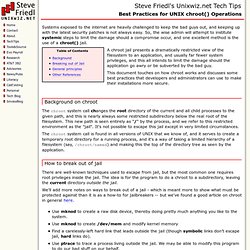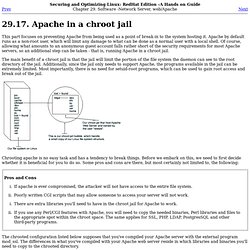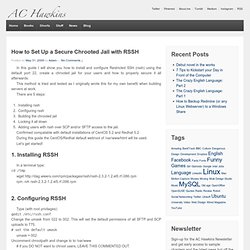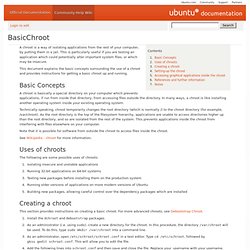

Best Practices for UNIX chroot() Operations. Systems exposed to the internet are heavily challenged to keep the bad guys out, and keeping up with the latest security patches is not always easy.

So, the wise admin will attempt to institute systemic steps to limit the damage should a compromise occur, and one excellent method is the use of a chroot() jail. A chroot jail presents a dramatically restricted view of the filesystem to an application, and usually far fewer system privileges, and this all intends to limit the damage should the application go awry or be subverted by the bad guy. This document touches on how chroot works and discusses some best practices that developers and administrators can use to make their installations more secure. The chroot system call changes the root directory of the current and all child processes to the given path, and this is nearly always some restricted subdirectory below the real root of the filesystem.
Almost all jail breaking requires root privileges. Building chroot jails with the Linux yum utility. Most modern Linux distributions ship with various technologies to boost security.

Amongst these technologies are such things as SELinux, AppArmor, ExecShield, iptables and disabling uneeded services by default. While these solutions have their benefits, the best and brightest hackers can typically find ways to work around them to compromise applications that are running on a server. Linux: How To Create Multiple Users Accounts in Batch. Security - Jail user to home directory while still allowing permission to create and delete files/folders. ConfigExamples/ChrootJail. Running Apache in chroot jail - Linux Howtos and FAQs. Apache in a chroot jail. This part focuses on preventing Apache from being used as a point of break-in to the system hosting it.

Apache by default runs as a non-root user, which will limit any damage to what can be done as a normal user with a local shell. Of course, allowing what amounts to an anonymous guest account falls rather short of the security requirements for most Apache servers, so an additional step can be taken - that is, running Apache in a chroot jail. The main benefit of a chroot jail is that the jail will limit the portion of the file system the daemon can see to the root directory of the jail. Additionally, since the jail only needs to support Apache, the programs available in the jail can be extremely limited.
Most importantly, there is no need for setuid-root programs, which can be used to gain root access and break out of the jail. Create "chroot jail" for bind. Posted by kroshka on Wed 18 Apr 2007 at 12:30 This article will explain how to create a chroot jail for bind8. This effectively makes bind oblivious to the rest of the (file)system beyond it's chroot directory tree. Therefore security will be increased, because if bind due to some crack attempt allows shell access one can not go beyond the chroot environment. (Quoting bind howto): "The idea behind chroot is fairly simple. When you run BIND (or any other process) in a chroot jail, the process is simply unable to see any part of the filesystem outside the jail.
"The idea behind running BIND in a chroot jail is to limit the amount of access any malicious individual could gain by exploiting vulnerabilities in BIND. Linux Knowledge Base and Tutorial. Int main ( void ) » chroot shell tutorial. Chroot-BIND HOWTO. How to Set Up a Secure Chrooted Jail with RSSH. In this guide I will show you how to install and configure Restricted SSH (rssh) using the default port 22, create a chrooted jail for your users and how to properly secure it all afterwards.

This method is tried and tested as I originally wrote this for my own benefit when building servers at work. There are 5 steps: Installing rsshConfiguring rsshBuilding the chrooted jailLocking it all downAdding users with rssh over SCP and/or SFTP access to the jail. Confirmed compatable with default installations of CentOS 5.2 and Redhat 5.2 During this guide the CentOS/Redhat default webroot of /var/www/html will be used. Let’s get started! In a terminal type:cd /tmp wget. Using SSH in a chroot environment - ulf.zeitform.de. Go Directly to Jail. Available on all Linux and Unix systems, chroot jails can secure untrusted applications and make trusted ones almost impenetrable.
Here's how to build them. “Security” is one of those “buzzwords du jour,” and there seems to be as many approaches to security as there are opinions on Microsoft. However, unlike other hot topics (or “CEO hot buttons”) that come and go, effort spent on security almost always pays off. Moreover, having a multitude of security techniques is a very good thing. There are umpteen ways to hack a system, and the savvy system administrator maintains a substantial and varied arsenal of countermeasures. Application jails, also known as “change root jails” or “chroot jails,” are another effective countermeasure. This month, let’s learn about jails.
Uprooting Root The chroot() system call has been with UNIX since at least Version 7 (released in 1979). What does that mean? CHROOT Tutorial - Antionline Forums. Chroot users with OpenSSH: An easier way to confine users to their home directories. June 24, 2008, 6:07 AM PDT. Create a simple chroot jail. This article provides several easy steps that would allow you to create a most basic chroot-ed environment for a user on your Linux/Unix based system.
It will really just show the basics of what a chroot jail is like, so that an inexperienced user can have some grounds to start learning and experimenting on their own. An Ubuntu 10.04 Desktop operating system was used for this example, but the instructions should be applicable to most Linux/Unix based operating systems. So, let’s start: 1. Create the user-to-be-jailed. In this example, the user will be called michael. Chroot-BIND HOWTO: Preparing the Jail. NextPreviousContents 2. Preparing the Jail 2.1 Creating a User As mentioned in the introduction, it's not a good idea to run BIND as root. So, before we begin, let's create a separate user for BIND. Securing Debian Manual - Chroot environment for SSH. [ previous ] [ Contents ] [ 1 ] [ 2 ] [ 3 ] [ 4 ] [ 5 ] [ 6 ] [ 7 ] [ 8 ] [ 9 ] [ 10 ] [ 11 ] [ 12 ] [ A ] [ B ] [ C ] [ D ] [ E ] [ F ] [ G ] [ H ] [ next ] Creating a restricted environment for SSH is a tough job due to its dependencies and the fact that, unlike other servers, SSH provides a remote shell to users.
Thus, you will also have to consider the applications users will be allowed to use in the environment. You have two options to setup a restricted remote shell: Chrooting the ssh users, by properly configuring the ssh daemon you can ask it to chroot a user after authentication just before it is provided a shell. Each user can have their own environment. The first option has the advantage of making it possible to have both non-chrooted and chrooted users, if you don't introduce any setuid application in the user's chroots it is more difficult to break out of it.
G.1 Chrooting the ssh users G.1.1 Using libpam-chroot The /proc filesystem needs to be mounted in the users' chroot. Jail user to /home/user directory. Yes i will try it and post my results - i havnt had a chance yet... i should probably restate my aims. i have a client that is insisting on a secure file tranfer solution. Being a lazy person i opted for somthing that i thought would be easiest - sshd - being present on almost every standard linux distro. i had originally wanted to use RSSH to limit what the ssh user could do, ie: not issue commands like "useradd" "chown" "chmod" and thigns like that.
A small how-to on how to chroot a user in bash shell. Restricting Users To SFTP Plus Setting Up Chrooted SSH/SFTP (Debian Squeeze. Version 1.0 Author: Falko Timme <ft [at] falkotimme [dot] com> Linux Configure rssh Chroot Jail To Lock Users To Their Home Directories Only. Rssh support chrooting option.

If you want to chroot users, use chrootpath option. It is used to set the directory where the root of the chroot jail will be located. This is a security feature. A chroot on Linux or Unix OS is an operation that changes the root directory. It affects only the current process and its children. BasicChroot. A chroot is a way of isolating applications from the rest of your computer, by putting them in a jail.

This is particularly useful if you are testing an application which could potentially alter important system files, or which may be insecure. This document explains the basic concepts surrounding the use of a chroot and provides instructions for getting a basic chroot up and running. Basic Concepts A chroot is basically a special directory on your computer which prevents applications, if run from inside that directory, from accessing files outside the directory. Creating a Chroot Jail for SSH Access. I wanted to setup a way to allow SSH access to my machine but limit their abilities heavily.

To do that I figured a chroot jail was the best way. In this example I'm using ArchLinux and OpenSSH 5.1p1. It should be a very similar process on any *nix operating system. Setup your test user The way I'm setting this up, is that all my chrooted users will be added to the sshusers group. .
$ groupadd sshusers $ adduser -g sshusers user Setup the jail directories The next step is to setup all the directories needed. JMC Research - Juan M. Casillas Web Site.